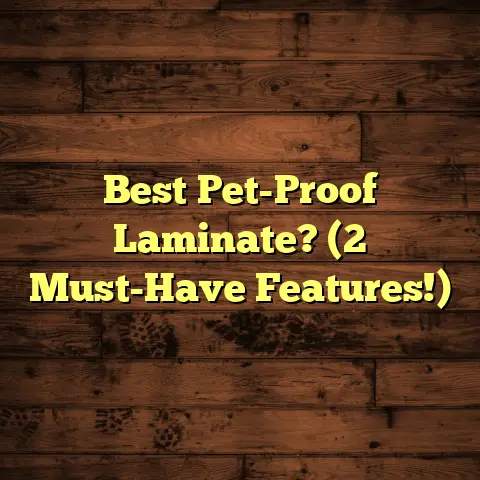How Do You Remove Stains On Hardwood Floors? (Explained)
Removing stains from hardwood floors can be a daunting task, especially if you’re dealing with a beloved surface that has seen years of wear and tear. I remember when I first moved into my home; the hardwood floors were beautiful but had a few unsightly stains that needed attention. Over time, I’ve learned quite a bit about effective methods for cleaning and maintaining these surfaces, and I’d like to share my experiences to help you tackle any stains you might encounter.
Identifying the Stain
Before diving into removal methods, it’s crucial to identify the type of stain you’re dealing with. Here are the most common types I’ve encountered:
- Water Stains: These appear as white spots, often from condensation or spills.
- Oil-Based Stains: These can come from cooking oils or greasy foods.
- Ink Stains: Often the result of pen marks or spills from ink.
- Pet Stains: Typically more challenging due to odor and discoloration.
- Food Stains: These might come from sauces, juices, or other food items.
Identifying the stain type is critical because different materials and techniques are effective for different stains.
Basic Cleaning Methods
1. Water Stains
For water stains, I found success using a simple technique. Here’s how I tackled it:
- Materials Needed: Soft cloth, white vinegar, and olive oil.
- Process:
- Mix equal parts of white vinegar and olive oil in a small bowl.
- Apply the mixture with a soft cloth, rubbing gently in circles.
- Wipe with a clean cloth to remove excess.
This method worked well for me on several occasions, and I appreciated that it was cost-effective—around $5 for the vinegar and oil combined. Initially, I was skeptical about using vinegar on wood floors due to its acidity, but in moderation and when mixed with oil, it proved helpful.
2. Oil-Based Stains
When dealing with oil stains, I learned that absorbing the excess oil is crucial:
- Materials Needed: Baking soda or cornstarch.
- Process:
- Sprinkle baking soda or cornstarch over the stain.
- Let it sit for 15-20 minutes to absorb the oil.
- Vacuum up the powder and wipe the area with a damp cloth.
While this method was effective, I did face challenges with particularly stubborn stains that required multiple applications. For example, after a kitchen mishap where oil splattered across the floor, I had to repeat this process three times before seeing significant improvement.
Advanced Techniques
If basic methods don’t cut it, here are some advanced techniques I’ve employed:
1. Sanding
For deeper stains or scratches, sanding might be necessary. This is a more labor-intensive process but can yield great results:
- Materials Needed: Sandpaper (start with 120 grit), vacuum, and finish (like polyurethane).
- Process:
- Use sandpaper to gently sand the stained area until you reach bare wood.
- Vacuum thoroughly to remove dust.
- Apply your chosen finish to protect the wood.
I sanded a particularly large stain in my living room after a wine spill that had set in overnight. While it took about two hours, the results were worth it. However, this method can be costly if you hire a professional—ranging from $3 to $5 per square foot.
2. Commercial Cleaners
In some cases, I resorted to commercial cleaners specifically designed for hardwood floors:
- Pros: Formulated for tough stains; often effective on various types of marks.
- Cons: Can range from $10 to $30 per bottle, and I found some products left residues that required additional cleaning.
One product that stood out was a hardwood floor cleaner I picked up at my local hardware store for about $15. It worked wonders on food stains but was less effective on grease marks.
Tips for Prevention
Through trial and error, I’ve learned several preventative measures to avoid future stains:
- Regular Maintenance: Sweep or vacuum regularly to remove dirt that can scratch the surface.
- Immediate Cleanup: Attend to spills immediately to prevent them from setting in.
- Rugs and Mats: Place rugs in high-traffic areas and under furniture to minimize wear.
- Use Furniture Pads: Protect your floors from scratches by placing felt pads under furniture legs.
Dealing with Specific Stains
Pet Stains
As a pet owner, I’ve faced my fair share of pet-related mishaps on my hardwood floors. For urine stains, it’s essential to act quickly:
- Blot up as much urine as possible using paper towels.
- Clean the area using a mixture of white vinegar and water (1:1 ratio) to neutralize odors.
- Rinse with clean water and dry thoroughly.
Despite my best efforts, some pet stains have left behind lingering odors or discoloration. In such cases, I found enzyme-based cleaners specifically designed for pet messes highly effective.
Food Stains
Food spills can lead to sticky residues or discoloration. Here’s how I managed them:
- For sticky substances like syrup or sauce, use warm water with mild dish soap applied with a soft cloth.
- Rinse with clean water and dry promptly.
I once had a disastrous pancake breakfast that resulted in syrup everywhere! After cleaning it up with warm soapy water, I didn’t notice any residual stickiness.
The Impact of Humidity
Humidity plays a significant role in hardwood flooring maintenance. High humidity can cause wood to swell, while low humidity can lead to shrinkage and gaps between boards. Here’s how to maintain balance:
- Use a Dehumidifier: In humid months, running a dehumidifier can help keep moisture levels stable.
- Humidity Monitors: Consider investing in a hygrometer to monitor indoor humidity levels.
Understanding your home’s humidity levels can help prevent future issues that lead to stains or damage.
Long-Term Maintenance Strategies
To maintain the beauty of hardwood floors over time, consider these long-term strategies:
Regular Professional Cleaning
While basic cleaning is essential, hiring professionals for deep cleaning every few years can do wonders for your floors’ appearance. These services typically use specialized equipment and products that are not available for home use.
Refinishing
Refinishing your hardwood floors every few years can also help restore their original luster and remove many stains and scratches:
- Materials Needed: Sanding equipment, stain (if desired), finish (like polyurethane).
- Process:
- Sand down the entire floor.
- Apply stain (if desired).
- Finish with multiple coats of polyurethane for protection.
I had my floors refinished after about eight years of wear and tear, which cost around $2 per square foot but made them look brand new again.
Comparing Approaches
When considering different approaches to stain removal on hardwood floors, here’s a comparative analysis based on my experiences:
| Method | Pros | Cons | Best For |
|---|---|---|---|
| Vinegar & Olive Oil | Cost-effective; easy to apply | May not work on tough stains | Light water stains |
| Baking Soda | Absorbs oil effectively | Requires multiple applications | Oil-based stains |
| Sanding | Effective for deep stains; restores finish | Labor-intensive; may require refinishing | Severe stains |
| Commercial Cleaners | Formulated for various stains | Can leave residues; cost varies | General purpose cleaning |
| Professional Help | Expertise; specialized equipment | Higher cost; scheduling required | Deep cleaning/refinishing |
Conclusion
In my journey of removing stains from hardwood floors, I’ve discovered that success often comes down to proper identification and timely action. While there are various methods available—from basic home remedies to more advanced techniques—it’s essential to choose one that suits your specific situation and skill level.
Comparatively, while DIY solutions can save money and yield satisfactory results, sometimes investing in professional help is worth considering for severe cases. In the end, maintaining my hardwood floors has not only preserved their beauty but has also added value to my home. Each method has its advantages and challenges, but with patience and the right approach, any stain can be addressed effectively.
If you find yourself facing a stubborn stain or just want to ensure your hardwood floors remain pristine for years to come, remember that prevention is key. Regular maintenance combined with prompt attention to spills will keep your floors looking their best while minimizing the need for extensive repairs or deep cleaning in the future.
By sharing my experiences and insights into maintaining hardwood floors, I hope you feel better equipped to handle any challenges you may encounter along the way. Don’t hesitate to experiment with different methods until you find what works best for you—after all, every floor tells its own story!





